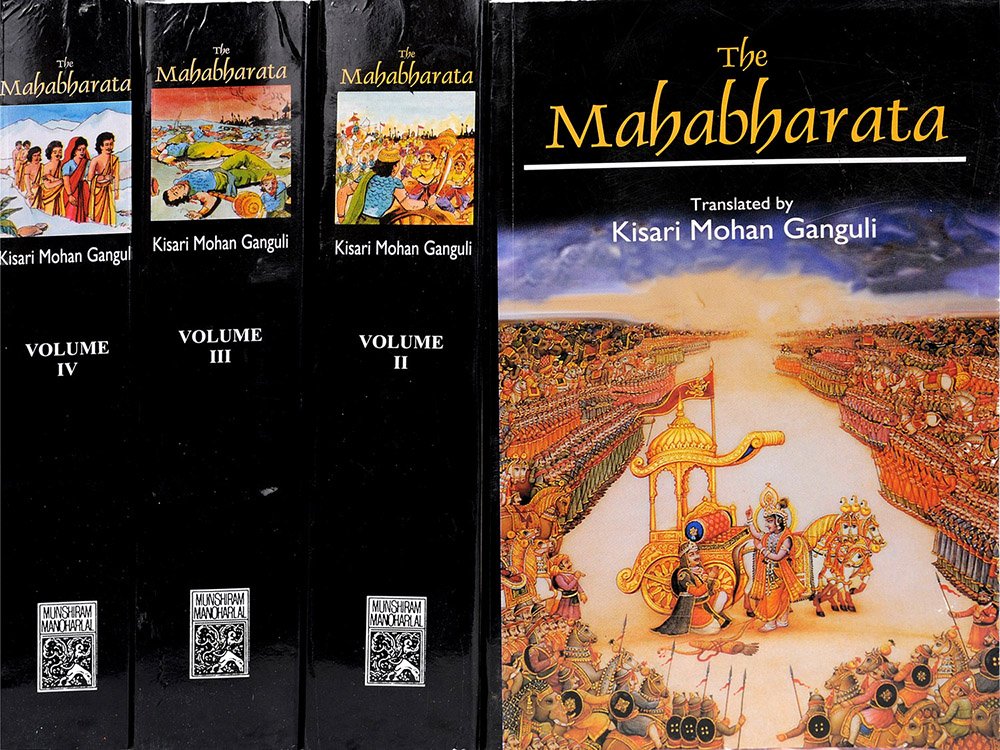Mahabharata (English)
by Kisari Mohan Ganguli | 2,566,952 words | ISBN-10: 8121505933
The English translation of the Mahabharata is a large text describing ancient India. It is authored by Krishna-Dwaipayana Vyasa and contains the records of ancient humans. Also, it documents the fate of the Kauravas and the Pandavas family. Another part of the large contents, deal with many philosophical dialogues such as the goals of life. Book...
Section XVII
"Vaisampayana said, 'Thus insulted by the Suta’s son, that illustrious princess, the beautiful Krishna, eagerly wishing for the destruction of Virata’s general, went to her quarters. And Drupada’s daughter of dark hue and slender waist then performed her ablutions. And washing her body and cloths with water Krishna began to ponder weepingly on the means of dispelling her grief.
And she reflected, saying,
'What am I to do? Whither shall I go? How can my purpose be effected?'
And while she was thinking thus, she remembered Bhima and said to herself,
'There is none else, save Bhima, that can today accomplish the purpose on which my heart is set!'
And afflicted with great grief, the large-eyed and intelligent Krishna possessed of powerful protectors then rose up at night, and leaving her bed speedily proceeded towards the quarters of Bhimasena, desirous of beholding her lord. And possessed of great intelligence, the daughter of Drupada entered her husband’s quarters, saying,
'How canst you sleep while that wretched commander of Virata’s forces, who is my foe, yet lives, having perpetrated today that (foul act)?'
"Vaisampayana continued, 'Then the chamber where Bhima slept, breathing hard like a lion, being filled with the beauty of Drupada’s daughter and of the high-souled Bhima, blazed forth in splendour. And Krishna of sweet smiles, finding Bhimasena in the cooking apartments, approached him with the eagerness of a three-year old cow brought up in the woods, approaching a powerful bull, in her first season, or of a she-crane living by the water-side approaching her mate in the pairing season. And the Princess of Pancala then embraced the second son of Pandu, even as a creeper embraces a huge and mighty Sala on the banks of the Gomati. And embracing him with her arms, Krishna of faultless features awaked him as a lioness awakes a sleeping lion in a trackless forest. And embracing Bhimasena even as a she-elephant embraces her mighty mate, the faultless Pancali addressed him in voice sweet as the sound of a stringed instrument emitting Gandhara note.
And she said,
'Arise, arise! Why dost you, O Bhimasena, lie down as one dead? Surely, he that is not dead, never suffers a wicked wretch that has disgraced his wife, to live.'
And awakened by the princess, Bhima of mighty arms, then rose up, and sat upon his couch overlaid with a rich bed. And he of the Kuru race then addressed the princess—his beloved wife, saying,
'For what purpose hast you come hither in such a hurry? Your colour is gone and you lookest lean and pale. Tell me everything in detail. I must know the truth. Whether it be pleasurable or painful, agreeable, or disagreeable, tell me all. Having heard everything, I shall apply the remedy. I alone, O Krishna, am entitled to your confidence in all things, for it is I who deliver you from perils again and again! Tell me quickly what is your wish, and what is the purpose that is in your view, and return you to your bed before others awake.'"
Conclusion:
This concludes Section XVII of Book 4 (Virata Parva) of the Mahabharata, of which an English translation is presented on this page. This book is famous as one of the Itihasa, similair in content to the eighteen Puranas. Book 4 is one of the eighteen books comprising roughly 100,000 Sanskrit metrical verses.
FAQ (frequently asked questions):
Which keywords occur in Section XVII of Book 4 of the Mahabharata?
The most relevant definitions are: Krishna, Bhima, Bhimasena, Drupada, Vaisampayana, Virata; since these occur the most in Book 4, Section XVII. There are a total of 14 unique keywords found in this section mentioned 30 times.
What is the name of the Parva containing Section XVII of Book 4?
Section XVII is part of the Kicaka-badha Parva which itself is a sub-section of Book 4 (Virata Parva). The Kicaka-badha Parva contains a total of 12 sections while Book 4 contains a total of 4 such Parvas.
Can I buy a print edition of Section XVII as contained in Book 4?
Yes! The print edition of the Mahabharata contains the English translation of Section XVII of Book 4 and can be bought on the main page. The author is Kisari Mohan Ganguli and the latest edition (including Section XVII) is from 2012.
